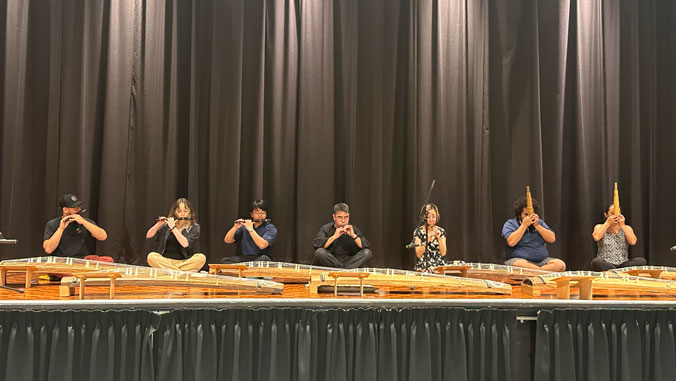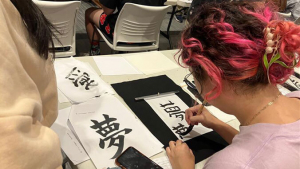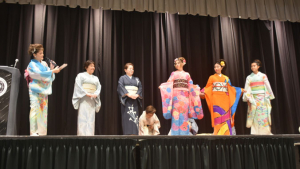
About 850 students packed the Campus Center Ballroom at the University of Hawaiʻi at Mānoa to soak in a diverse selection of traditional and contemporary elements of Japanese culture. Organized by the Japanese section of the Department of East Asian Languages and Literatures (EALL), the annual Nippon Culture Day event on October 20 featured a plethora of educational workshops for Hawaiʻi high school and college students, such as origami (paper folding), calligraphy, gift wrapping, Okinawan language, hanafuda playing cards, manga/anime drawing, and traditional kimono and 13-string koto (zither instrument) demonstrations.

“Most workshops offer hands-on ‘make and take’ sessions that students won’t be able to experience in the classroom,” said Yumiko Tateyama, a Japanese language instructor at EALL. “We hope that the students will take with them a newfound knowledge of the historical roots and meaning behind traditional arts and crafts that are presented.”
The event is co-sponsored by the Center for Japanese Studies and the Center for Okinawan Studies and also spotlighted tea ceremony and ikebana (flower arrangement) activities for attendees.
Traditional cards, reigi lessons
Nippon is the Japanese word for Japan, and Kaito Yamanaka, a junior at UH Mānoa majoring in Japanese and economics, hopes to make a living there after college. This year, Yamanaka volunteered at the karuta exhibit. The ancient card game traces back to 16th century Japan and requires players to match cards associated with short poems or phrases recited during the game.
“I’ve played karuta since I was small, so I enjoyed teaching it to others and seeing them have fun with the game,” Yamanaka said.
One of the newest workshops featured at this year’s event focused on reigi, which is the Japanese words for etiquette and manners. Organizers invited Keiko Okawa, a consul from the Consulate-General of Japan in Honolulu, to shine light on a critical custom— bowing.

“I told the participants that the key to a proper bow is breathing. Thus, you can put your heart to your movement. You inhale as you bow, pause to exhale, and then inhale again as you rise,” Okawa explained. “I believe that learning how to bow properly will be helpful to you when you travel to Japan and want to express your sincere gratitude to someone, or when you work for a Japanese company.”
Okawa also taught students other protocols practiced in Japan’s professional sector, including how to properly present a business card.
Local companies and organizations such as Hawaiian Airlines and Aulani, a Disney Resort & Spa were also present at the event to provide students the opportunity to network and learn about future career prospects.
EALL is housed in the UH Mānoa College of Arts Languages and Letters.

